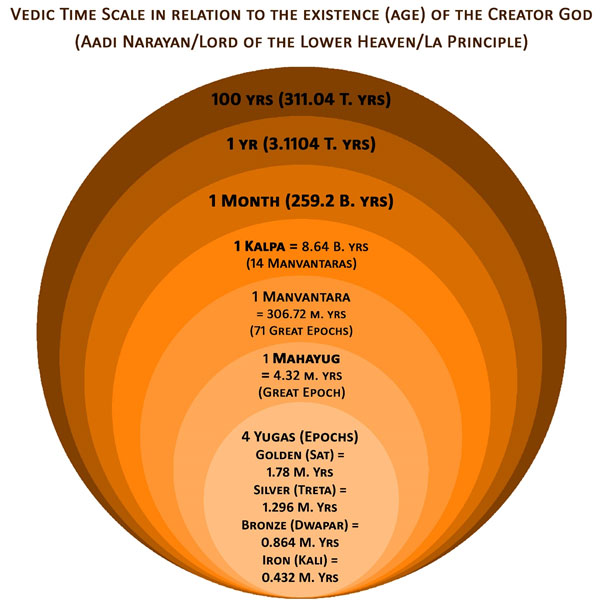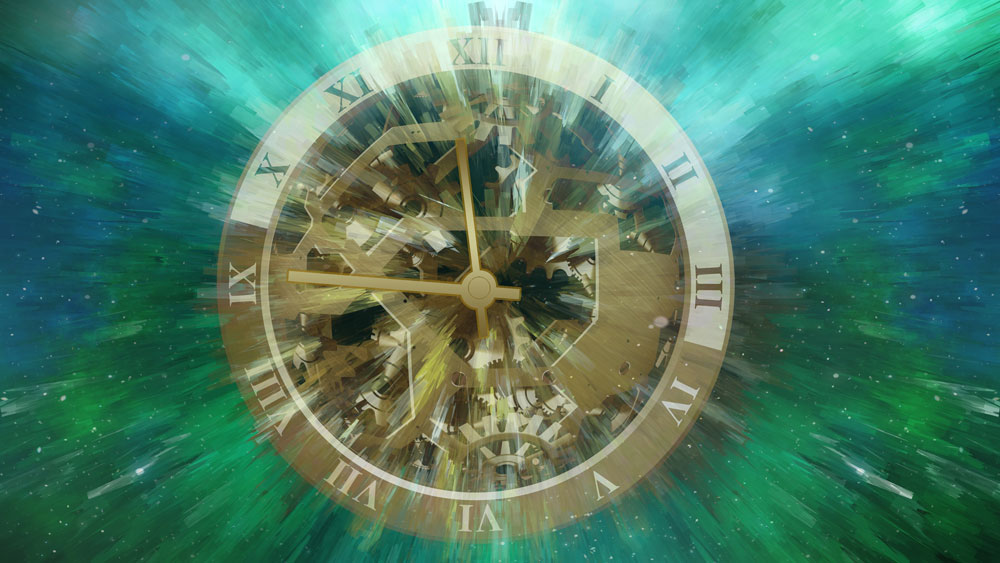A Spirituo-Scientific Synthesis
Indian Vedic Time Scale
The Renowned Astronomer and Cosmologist Carl Sagan once said, “The Hindu religion is the only one of the world’s great faiths dedicated to the idea that the Cosmos itself undergoes an immense, indeed an infinite, number of deaths and rebirths. It is the only religion in which the time scales correspond to those of modern scientific cosmology. Its cycles run from our ordinary day and night to a day and night of Brahma, 8.64 billion years long. Longer than the age of the Earth or the Sun and about half the time since the Big Bang”.
Science has only recently understood all facets of Nature like quantum mechanics, chaos theory, particle physics, big bang, cosmology, dark matter and dark energy etc. However, ancient Vedic wisdom had already envisaged all these aspects of Nature.
Vedic timescale does, in fact, map well with the current understanding of Science. On a descending order, the Vedic timescale finds listed as ‘Mahapralaya or the great dissolution, Pralaya or the dissolution, Kalpas or aeons, Manvantaras or duration of manus and Yugas or eras’. These Vedic timescales represent the time points in the lifetime of the Creator God (Aadi Narayan). (Note: The Creator God is not Brahma as popularly known. See another blog in this connection)
Hindu timescale based on Astronomical Science
Our manifest Cosmos and Universes, which are transient, represent a state of duality, unlike the eternal domains or dimensions where there is no time-space concept as they are in a state of unity. In the dimension of created Cosmos, everything is cyclical, including the time itself, because of the time-space manifestation.
Hindu’s perception of time had been cyclical. It ranges from days, weeks, months, years, seasons, yugas and epochs.
It is Gunita finding mention in the Manusmriti who initiated the Hindu time calculation.
He devised the calculation of the cycle of creation and dissolution in human years. Similarly, the Creator God’s timescale from the time of manifestation of the Cosmos came to be known as cosmic time scale consisting of Kalpas. A full Kalpa, representing a full day of the Creator God, is equal to 8.64 billion human years. This full Kalpa consists of a day Kalpa (day time) and a night Kalpa (night time) of the C. God. There is the existence of creation during the day time of C. God and no presence of creation during the night time. In short, new creation comes into existence with the dawn of the C. God, and the creation undergoes dissolution (pralaya – a Hindu term) at dusk. So, we have a half Kalpa of day time with the creation and a half Kalpa of the night time with no creation.
The half Kalpa of the day time, marked by creation, lasts 1000 Great Epochs (or epoch cycles). Each Kalpa or 1000 epoch cycles consists of 14 Manvantaras. This represents the periods of 14 Manus. That means each Manvantara includes 71 epoch cycles. As the 14 Manvantaras is equal to 4.32 billion years (which includes the interjection period of 1728000 years), each Manu’s duration is 306.72 million years.
The total life span of the Creator God is 100 cosmic years. Each cosmic year lasts 3.1104 trillion human years. Therefore 100 years of the Creator God equal 311.04 trillion human (solar) years.
A Tabular Understanding of the Mega Time Scale
According to Hindu mythological texts, the calculation of time scales relates to the Creator God’s age. He can also be called or known as the Super Soul, Cosmic Consciousness, Lord of the Lower Heaven, La Purush (La Principle), Kshar Purush (Kshar Principle) or Aadi Narayan. His one day time of 12 hours is a Kalpa, and his night time of 12 hours is equal to another Kalpa. So, his one 24 hour day is equivalent to 2 Kalpas.
What it means is that one divine day of the Creator God is equal to two kalpas. One Kalpa is equal to 1000 cycles of Great Epochs. One Great Epoch consists of four epochs.
1 Great Epoch (Mahayug) (Grand total of all the 4 Epochs or Yugas also known as Epoch Cycles) = 4,320,000 Years (4.32 million years)
71 Great Epochs (Mahayuga) = 43,20,000 X 71 = 1 Manvantar
1 Manvantara = 30,6720,000 Years (306.72 million years)
14 Manvantaras = 4,294,080,000 Years (4.294080 billion years)
=
One Kalpa
So, in 14 Manvantaras, the number of junctional years is equal to:
17,28,000 x 15 = 2,59,20,000 (25.920 million years)
1 Kalpa = 4320,000,000 years (4.320 billion years)
4, 294,080,000 + 2,59, 20, 000 = 4320, 000, 000 or 4.32 billion years.
1 Kalpa = 14 Manvantaras
1 Manvanatara = 306.72 million years
1 Kalpa consists of 14 Manvanataras = 306.72 x 14 = 4.320 billion years, including the junctional periods between each Manvantara.
1 Manvantara = 71 Great Epochs (Mahayugas)
1 Mahayuga (Great Epoch) = 4.320 million years (total of 4 epochs or yugas added together)
The duration and names of the four epochs or yugas are
- The Golden Epoch or the epoch of truth and perfection (Sataya-yuga or Krita-yuga) = 1.728 million years ( a period of peace and spiritual progress)
- The Silver Epoch or the epoch of 3/4th truth and perfection (Treta-yuga) = 1.296 million years.
- The Bronze Epoch or 1/2 Truth and perfection (Dvapar-yuga) = 864000 years
- The Iron Epoch or 1/4 truth and perfection (Kali-yuga) = 432000 years, also known as a Charana (marked by violence and spiritual degradation),

As is apparent, each succeeding epoch gets tinged with increasing negative qualities of passion, anger, desire or craving, greed, ego, falsehood etc., with a corresponding decrease in positive attributes of truth, perfection, peace and spirituality.
The Life of the Creator God in 100 years will be
4,32,00,00,000 x 2 x 360 x 100 = 311.0400000000 trillion solar years.
According to the Hindu cosmology, the entire 100-year duration of the Creator God has within it 36000 kalpas. We are now in the 7th Manvantara, the halfway stage. This would mean that we are in the 51st year of the Creator God, the halfway stage of his life. Apparently, 1,555,200,000,000 years (155.520 Trillion years) years have elapsed from the formation of the Cosmos. The Cosmos has, therefore, a life span of another 155.52 trillion years left.
Kalpa consist of 4,32,00,00,000 years and out of these 1,97,29,49,101 years have passed. Therefore, according to the calculations devised by our ancient sages, the Earth’s existence comes up to 1,97,29,49,101 years to date. It adds up to approximately 2 billion years, which is the rough time period of life on Earth according to scientific understanding. It is interesting to note that according to scientific calculations, the cosmos’ age (it should be the age of a galaxy and not a cosmos) stands estimated between 15 and 20 billion years.
Possibly:
A solar system lasts about 4 billion years (one day of Creator God = 1 Kalpa). Note: The origin of our solar system occurred about 4.5 billion years ago. So, the duration of the solar system, in terms of one day or Kalpa of the Creator God, has to be from the time of origin of life on Earth, roughly about 2 billion years ago. So, our solar system has another half life span left before annihilation (another 2 billion years).
A galaxy lasts about 15-20 billion years (About 4 – 5 days or Kalpas), the shortest; while some may last up to 60 – 61 billion years a week or 7 kalpas), the medium aged and yet others may last up to about 260 billion years (30 kalpas or a month), the long lived ones.
A Universe lasts about 3.11 trillion years (one year of Creator God = 360 Kalpas)
THE Cosmos lasts about 311 trillion years (Hundred years of Creator God = 36000 Kalpas).
Time as an Illusory aspect of the Created Cosmos
In the ancient Vedic tradition and Hinduism that followed, time gets related to creation. One aspect of creation is the manifestation of Nature (Prakriti), and this Nature remains ever permeated with the illusory entity called Maya. After creation, we, humans who have well developed five senses of perception, remain bound to the illusory percepts of Maya through our senses and the consequent gratification of sorts.
Everything is in perpetual motion in this created Universe, and time is an offshoot of the movements of our senses, celestial objects, and perceptions. Time becomes an essential aspect of our life pattern on this Earth, something we live with even though it is illusory and unreal. Therefore, its existence is a part of the domain of Cosmic Consciousness or Super Consciousness, meaning an illusory component of this manifest perishable Cosmos. In the realms of the Superior Consciousness and Supreme Consciousness (the Upper Heaven and the Supreme Heaven as per the Christian tradition; or SadaTul-Muntaha and Arse Ajeem as per Islamic tradition), there is only the present moment, an eternal, unchangeable or permanent state of existence.
The manifest Nature (Prakriti) keeps the individual souls (human beings or bits of Cosmic Consciousness) to the limitations of time (kaala), space (niyati), knowledge (Vidhya), passion (raaga), power (Satha), pride (vanity), anger (krodh), greed (lobh), desire (trishna) etc., aspects of Maya, and keeps the individual souls bound to the vicissitudes of birth and death. It is only when individual souls indulging in meditational endeavours get freed of the binding aspects of the illusory Maya that the part Consciousness regains its state of pure Consciousness and get rid of the cycles of birth and death.






Parveen Kumar
June 15, 2021 — 9:07 pm
The explanation requiring the fewest assumptions is most likely to be correct and the Vedic cosmology is a perfect example of it. I admire the way you dealt with this onerous subject.
Look forward to reading your next informative work.